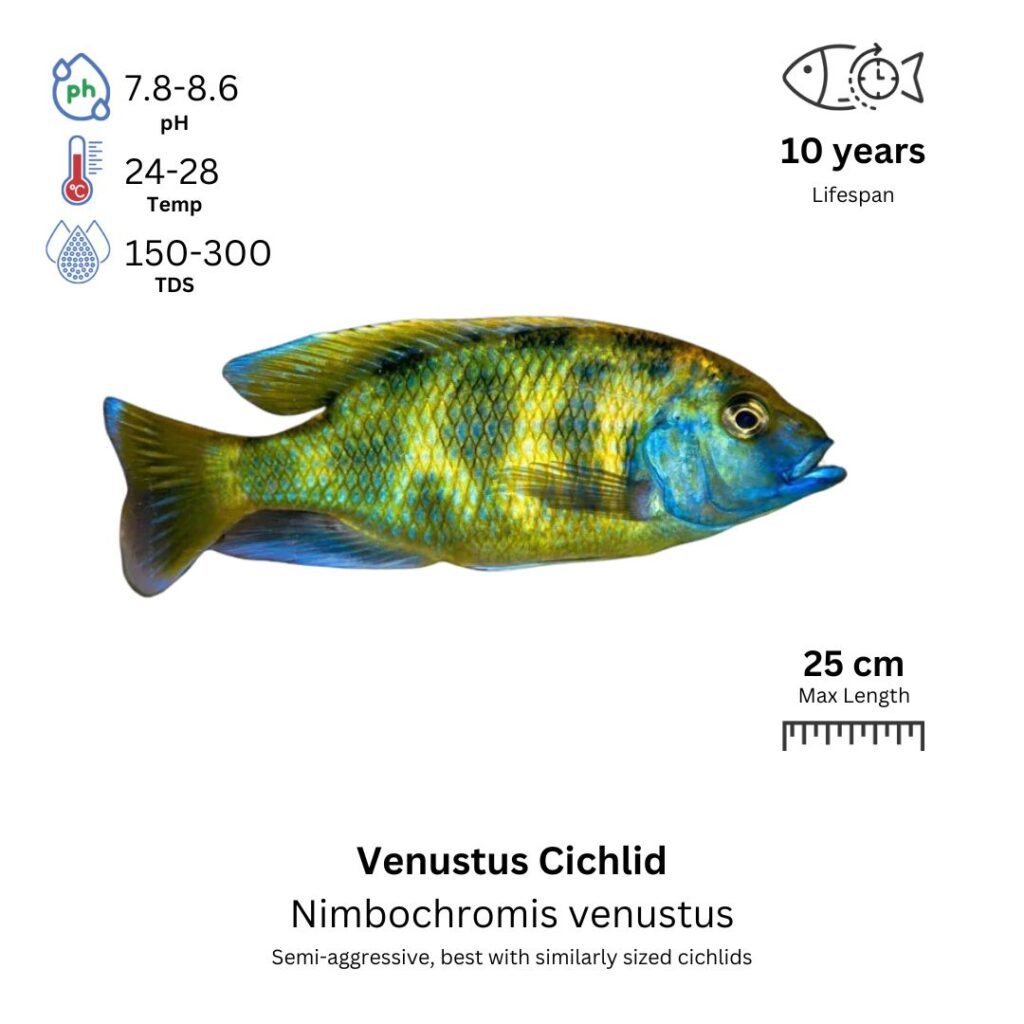Venustus Cichlid
Nimbochromis venustus

Description
The Venustus Cichlid is a stunning and large species of African cichlid known for its vibrant colors and distinctive patterns. Adult males are typically more colorful than females, with a base color ranging from blue to greenish hues, often with a metallic sheen. They feature dark vertical stripes that are more pronounced on the body and tail, along with a slightly elongated body shape. The head is more rounded with a slightly tapered snout, and they possess a large, impressive dorsal fin. Their coloration can vary slightly depending on environmental factors, but the males’ bright yellow or blue tones make them one of the most sought-after cichlids in the aquarium trade.
Habitat Origin
Native to Lake Tanganyika in East Africa, the Venustus Cichlid is typically found in rocky and sandy areas along the lake’s shores. These fish are often seen in deeper waters, near the substrate where they can forage for food. The environment in which they thrive is one that offers plenty of hiding spots and moderate water movement, with rocky crevices and submerged structures offering shelter. They prefer slightly alkaline water and require a well-oxygenated tank to stay healthy.
Aquarium
Ideal Number in Aquarium: Best kept singly or in pairs. If kept with other species, ensure the tank is large enough to provide territories and adequate space to reduce aggression.
Favorite Food

Venustus Cichlids are carnivorous and omnivorous and thrive on a varied diet. They can be fed high-quality cichlid pellets, live or frozen foods such as brine shrimp, bloodworms, daphnia, and krill. They also enjoy vegetable matter, so supplementing their diet with spirulina, blanched zucchini, and lettuce will provide essential nutrients. A well-balanced diet is key to maintaining their vibrant coloration and robust health.
Behavior:
Venustus Cichlids are active and semi-aggressive fish that often exhibit territorial behavior. They are best kept with other large, robust fish that can hold their own. Males, in particular, can become aggressive during breeding or when defending their territory. They are not typically overly aggressive, but they will stand their ground when threatened. Venustus Cichlids enjoy having plenty of hiding spots and structure in the tank, such as rocks, caves, and plants. They are often seen swimming in the middle to lower levels of the tank, exploring the environment and searching for food.
Special Care:
Venustus Cichlids require a stable and well-maintained environment with excellent filtration and regular water changes. They thrive in tanks that replicate their natural habitat, with plenty of rocks, caves, and crevices for shelter and territory. A fine, soft substrate such as sand is ideal for these fish, as it mimics the lakebed of Lake Tanganyika. It’s important to monitor the water quality and ensure that nitrate levels stay low, as cichlids are sensitive to poor water conditions.
Compatibility with Other Fish:
Venustus Cichlids are best kept with other large cichlids or robust species that can handle their semi-aggressive nature. They may do well with other Tanganyikan cichlids or large species such as African Tetras, Synodontis Catfish, and larger barbs. Smaller or more passive species should be avoided, as they may become stressed or eaten by the Venustus Cichlid. It’s essential to provide plenty of space and hiding spots to reduce territorial aggression, particularly in tanks with multiple cichlids.
Breeding Setup
A separate breeding tank is highly recommended for Venustus Cichlids due to their territorial and sometimes aggressive nature. A tank size of at least 300 liters (80 gallons) is ideal, giving the breeding pair plenty of space to establish territories and minimizing aggression. Maintain water parameters at a pH of 7.5–8.5, temperature of 26–30°C, and hardness of 10–20 dGH. Use a canister filter to handle their bioload but avoid creating strong currents. The ideal substrate is fine gravel or sand, with flat rocks or large stones to simulate their natural spawning surface. Lighting should be moderate, with a 10–12 hour light cycle to mimic natural conditions.
Conditioning for Breeding
To prepare Venustus Cichlids for breeding, feed them a high-quality, protein-rich diet including live or frozen brine shrimp, bloodworms, daphnia, and premium cichlid pellets or flakes. This ensures the female produces healthy eggs and the male is in optimal condition for courtship. Perform weekly 20–30% water changes to maintain cleanliness and trigger spawning behavior. Slightly increasing the temperature to around 28°C can also help initiate breeding readiness.
Spawning Behavior
Spawning typically begins when the male displays vivid colors and courts the female by chasing and displaying near a chosen spawning site. Once receptive, the female will lay her eggs—up to 500 depending on size and health—on a flat rock or the tank bottom. The male then fertilizes the eggs. Uniquely, Venustus parents may guard the eggs together, with the female fanning them to provide oxygen and both parents offering protection. This cooperative behavior makes separation unnecessary unless aggression is observed.
Fry Care & Hatching
Eggs generally hatch within 3–5 days, depending on temperature. Once fry have absorbed their yolk sacs, they should be fed infusoria or liquid fry food. After a few more days, introduce newly hatched brine shrimp or finely crushed cichlid flakes to support growth. Maintain excellent water quality with small, frequent water changes (10–15% every 2–3 days), and use a sponge filter to avoid disturbing the fry. Stable temperature and plenty of hiding spots from rocks or decor help the fry thrive.
Breeding Tips
Venustus Cichlids become sexually mature at 1–2 years old, though females might be ready slightly earlier. Males are typically larger, more vibrant, and have longer, pointed fins, while females are rounder and paler, especially when gravid. To avoid stress, never overcrowd the tank, and avoid sudden changes in temperature, pH, or water hardness. Remove aggressive or incompatible tankmates to maintain a peaceful environment for breeding and rearing fry.
